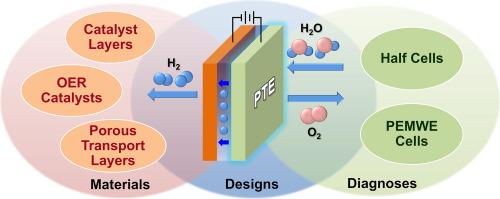Porous transport electrodes for oxygen evolution reaction in proton exchange membrane water electrolysis Cells: Materials, Designs, and diagnoses
IF 13.3
1区 工程技术
Q1 ENGINEERING, CHEMICAL
引用次数: 0
Abstract
H2 production using proton exchange membrane (PEM) water electrolysis (PEMWE) cells has received considerable attention because of the high efficiencies of these cells and no harmful emissions from the related process. In PEMWE cells, porous transport electrodes (PTEs) composed of a catalyst layer (CL) comprising O2 evolution reaction (OER) catalysts, porous transport layer (PTL), and PEM play key roles in the stack performance and lifetime. Herein, Ir-based and non-precious-metal OER catalysts that are highly active and stable at low pH values and high anodic potentials are reviewed to understand their OER mechanisms. Various strategies are proposed for engineering CLs and PTLs to improve the interfacial properties and mass transfers of reactants and products to and from the active sites. Additionally, diagnoses of PTEs is significantly crucial for interpreting electrochemical processes and addressing their current challenges. Therefore, half-cell analyses, including diffusion electrode (DE), floating electrode (FE), and modified rotating disk electrode (MRDE) techniques, are explored, and membrane electrode assembly (MEA)-based analyses, such as the polarization technique, electrochemical impedance spectroscopy, and magnetic field analysis, are established. This study aims to provide an overview of recent technologies used for the engineering and diagnostic tools of PEMWE cells and insights into the advanced components and systems to be developed in this field.

求助全文
约1分钟内获得全文
求助全文
来源期刊

Chemical Engineering Journal
工程技术-工程:化工
CiteScore
21.70
自引率
9.30%
发文量
6781
审稿时长
2.4 months
期刊介绍:
The Chemical Engineering Journal is an international research journal that invites contributions of original and novel fundamental research. It aims to provide an international platform for presenting original fundamental research, interpretative reviews, and discussions on new developments in chemical engineering. The journal welcomes papers that describe novel theory and its practical application, as well as those that demonstrate the transfer of techniques from other disciplines. It also welcomes reports on carefully conducted experimental work that is soundly interpreted. The main focus of the journal is on original and rigorous research results that have broad significance. The Catalysis section within the Chemical Engineering Journal focuses specifically on Experimental and Theoretical studies in the fields of heterogeneous catalysis, molecular catalysis, and biocatalysis. These studies have industrial impact on various sectors such as chemicals, energy, materials, foods, healthcare, and environmental protection.
 求助内容:
求助内容: 应助结果提醒方式:
应助结果提醒方式:


